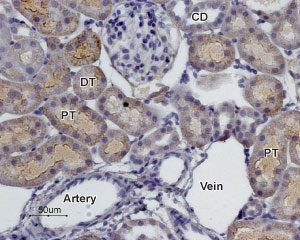Overview
- Peptide (C)RRPDGAAYPQ*SGLNDE, corresponding to amino acid residues 192-207 of rat α2C-adrenoceptor with replacement of cysteine 202 (C202) with serine (*S) (Accession P22086). 2nd extracellular loop.

 Western blot analysis of rat lung (lanes 1 and 4), kidney (lanes 2 and 5) and brain (lanes 3 and 6) membranes:1-3. Anti-α2C-Adrenergic Receptor (extracellular) Antibody (#AAR-022), (1:200).
Western blot analysis of rat lung (lanes 1 and 4), kidney (lanes 2 and 5) and brain (lanes 3 and 6) membranes:1-3. Anti-α2C-Adrenergic Receptor (extracellular) Antibody (#AAR-022), (1:200).
4-6. Anti-α2C-Adrenergic Receptor (extracellular) Antibody, preincubated with α2C-Adrenergic Receptor (extracellular) Blocking Peptide (#BLP-AR022).
 Expression of α2C-Adrenoreceptor in rat kidneyImmunohistochemical staining of rat kidney paraffin embedded sections using Anti-α2C-Adrenergic Receptor (extracellular) Antibody (#AAR-022), (1:100). α2C-Adrenoreceptor is expressed in both proximal (PT) and distal (DT) renal tubules and in the collecting ducts (CD). Hematoxilin is used as the counterstain.
Expression of α2C-Adrenoreceptor in rat kidneyImmunohistochemical staining of rat kidney paraffin embedded sections using Anti-α2C-Adrenergic Receptor (extracellular) Antibody (#AAR-022), (1:100). α2C-Adrenoreceptor is expressed in both proximal (PT) and distal (DT) renal tubules and in the collecting ducts (CD). Hematoxilin is used as the counterstain.
- IUPHAR RECEPTOR DATABASE | ADRENOCEPTORS.
- Piascik, M.T. and Perez, D. M. (2001) J. Pharmacol. Exp. Ther. 298, 403.
- Murphy, T.J. and Bylund, D.B. (1988) J. Pharmacol. Exp. Ther. 244, 571.
- Blaxall, H.S. et al. (1991) J. Pharmacol. Exp. Ther. 259, 323.
- Bjorklind M. et al. (1999) Neuroscience 88, 1187.
- Tanila H. et al. (1999) Eur. J. Neurosci. 11, 599.
Adrenergic receptors (also called adrenoceptors) are the receptors for the catecholamines adrenaline and noradrenaline (called epinephrine and norepinephrine in the United States). Adrenaline and noradrenaline play important roles in the control of blood pressure, myocardial contractile rate and force, airway reactivity, and a variety of metabolic and central nervous system functions.
Adrenergic receptors are members of the G-protein coupled receptor (GPCR) superfamily of membrane proteins. They share a common structure of seven putative transmembrane domains, an extracellular N-terminus, and a cytoplasmic C- terminus.
Adrenoceptors are divided into three types: α1, α2 and β-adrenoceptors. Each type is further divided into at least three subtypes: α1A, α1B, α1D, α2A, α2B, α2C, β1, β2, β31,2. Adrenoceptors are expressed in nearly all peripheral tissues and in the central nervous system1,2.
The α2C-adrenoceptor subtype was identified by binding studies in the opossum kidney and in cell lines from this organ (OK cells)3,4.
Surprisingly, the α2C-adrenoceptor subtype seems not to play a major role in cardiovascular regulation or the other classical effects of α2-adrenergic receptors5. Some researchers have suggested that the α2C-adrenoceptor subtype may play a role in modulating motor behaviour and perhaps in memory processes6.
Application key:
Species reactivity key:
Alomone Labs is pleased to offer a highly specific antibody directed against an extracellular epitope of the rat α2C-adrenoceptor. Anti-α2C-Adrenergic Receptor (extracellular) Antibody (#AAR-022) can be used for western blot and immunohistochemistry applications. It has been designed to recognize α2C-adrenoceptor from rat, mouse and human samples.
Applications
Citations
- Mouse sample:
Hamlett, E.D. et al. (2020) Neurobiol. Dis. 134, 104616.
